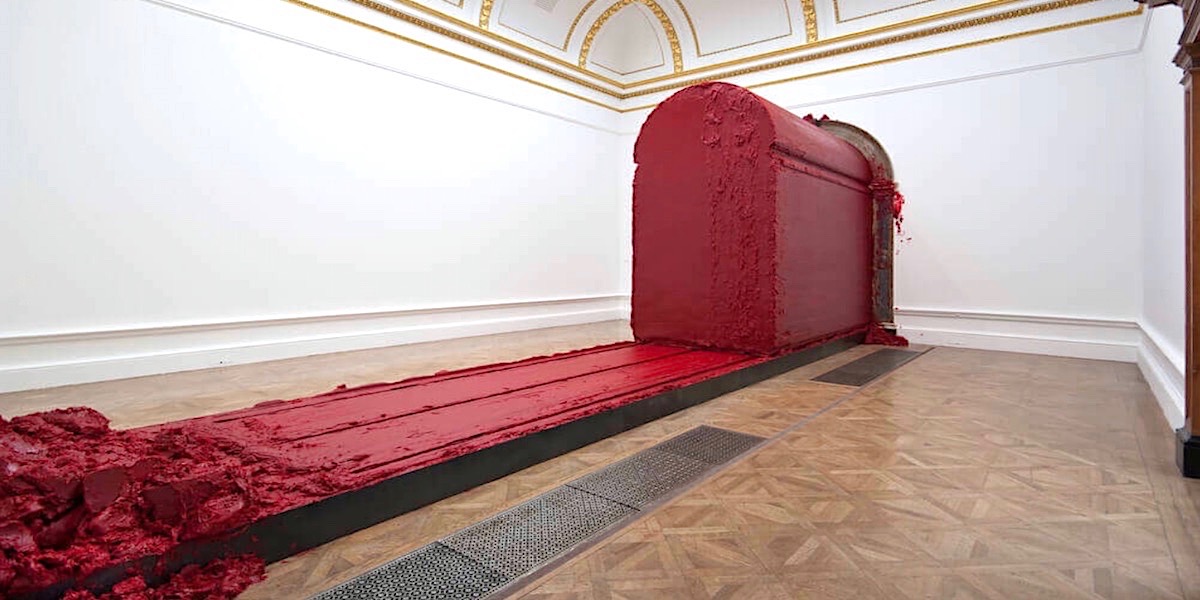The RA had never seen anything like it. A tumbrel covered in red Vaseline paint and wax trundling through the elegant 18th-century galleries evoking a range of images from slaughterhouse wagons to Nazi transport trucks. Walls splattered with a gloopy red mucus, fired from canons, suggestive of the aftermath of some horrific massacre. The shooting of the Tzars, perhaps? Or beheadings by Madame la Guillotine? Goodness knows what Turner or Joshua Reynolds would have made of it or those artists traditionally putting the finishing touches to their bucolic English landscapes on Varnishing Day. In the fine elegance of Burlington House, with all its associations of white privilege, Anish Kapoor’s lumbering train conjured images of India’s overcrowded railway system, built and administered by colonialism and constructed by native muscle, trains that slowly criss-cross the country, passengers dangerously hanging from the roofs and sides.
Authenticity favours the transmission of tradition; authority enhances the translation of tradition – AK
The title Svayambh taken from the Sanskrit – means ‘born for itself’ or ‘self-generated’. The slow-moving juggernaut became a metaphor for all emigrations and cultural cross fertilisations, for ancient trade routes, and the melding of Kapoor’s Indian, Middle Eastern and British experience. The abstracted railway carriage moving almost imperceptibly along its blood-red tracks through the galleries like the pendulum of some great timepiece, a physical reminder of the passage of history itself. Part theatrical stage set, part sculpture, the work sat within the tradition of 20th century abstract painting from Malevich to Mondrian, from Pollock to Newman. The red splattered walls echoed those of Cy Twombly’s Bacchus paintings shown at Tate Modern in 2008, with all the suggestion of societal breakdown and orgy. But it is Rothko’s influence that dominated. The use of the same visceral oxblood red, the framing of the rectangular mass of the lumbering cube in the high doorway, reminiscent of the totemic rectangles of Rothko’s red canvases and the intense, deep void created by his surfaces.
Anish Kapoor is known as a colourist and for his use of pure pigments – the Kleinian blues, ochres, reds and saffron yellows – sitting on the gallery floor like sumptuous spice piles in an oriental market. There has been a tendency to see him as an ‘Indian’ artist making work that links notions of the western sublime – Freud, Nietzsche and Romanticism – with a smattering of Buddhism, Hindu exoticism and spirituality to create a smorgasbord of contemporary multi-culturalism with a spiritual edge. Of course, these elements are present in his work. He grew up with a diverse background and was influenced by his Indian ancestry and British education. But, as the critic Homi K. Bhabha has argued, this attaches too much weight to the person rather than being an engagement with the artist’s practice. It essentialises the work, defining it as simply being the metaphysics of the transcendent and giving it a semi-sacred meaning. There has been a habit when discussing Kapoor’s work to over-use the notion of ‘authenticity’ rather than, as Bhabha suggests, engaging with its ‘conceptual authority’ – (his italics). The notion of authenticity, he argues, ‘focuses on protecting the sovereignty of form and tradition’, whereas authority ‘is established performatively, through an efficacious splitting of the art-object into iterative ‘nodes’ of influence that establish new networks of signification, and new formal possibilities of construction’. He goes on to suggest that: ‘Authenticity favours the transmission of tradition; authority enhances the translation of tradition.’
The implication must be that there can be no singular ‘meaning’ to a work such as Svayambh. Rather it is an exploration that occurs between occidental and oriental, between past and present, object and painting, pragmatism and metaphor. Kapoor is not a seer or a guru but a highly sophisticated maker who brings together – as a true postmodernist of his generation – an eclectic mix of influences, art history, ethnicity and fabrication techniques to make an object in space that suggests a multitude of narratives and possibilities born, ultimately, in the space between the object and the viewer. For one it may be a reminder of J.M.W. Turner’s plucky little black tug slowly pulling the redundant Fighting Temerarie to its breakup in the shipyard against a dying sun. Or Titian’s bloody and flayed Marsyas, or Soutine’s butchered Carcass of Beef. For another, it will be a reminder of the Trans-Siberian Railway journey or the huge whistling locomotives of the American railroad system, the Industrial Revolution and the pistons and machinery of Blake’s dark Satanic mills. It is about all these things but none of them in particular. Both monument and memory. It is also about architecture, object and surface, about painting and the emotive power of colour. A form that has invented itself, it is neither painting nor sculpture – but a visual, intellectual and emotional experience that sits between both. An object that allows us to coat it with and project onto it our various stories and myths about the human condition. An alien object in an elegant 18th gallery that demanded its own space.
When asked about the meaning of Svayambh, Kapoor answered: In one way, I do not know what this piece represents. What I am sure of, however, is that it has not real subject. Nothing in particular’. It is this very lack of specificity that encourages us to think allows our imaginations free reign.
Anish Kapoor’s Svayambh was exhibited at the Royal Academie 2009
Words: Sue Hubbard Photo: Courtesy Lisson Gallery
Her novel Rainsongs is published by Duckworth, Overlook Press US, Mercure de France and Yilin Press, China.
“Hubbard deserves a place in the literary pantheon near Colm Toibin, Anne Enright and Sebastian Barry”. American Library Association
Swimming to Albania, her fourth poetry collection is available from: www.salmonpoetry.com
Her fourth novel is due from Pushkin Press and Mercure de France 2023

